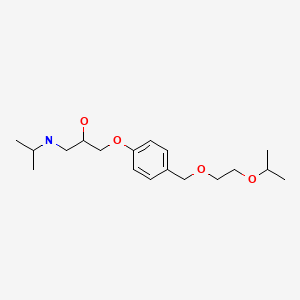Attribution Statement: LactMed is a registered trademark of the U.S. Department of Health and Human Services.
NCBI Bookshelf. A service of the National Library of Medicine, National Institutes of Health.
Drugs and Lactation Database (LactMed®) [Internet]. Bethesda (MD): National Institute of Child Health and Human Development; 2006-.
CASRN: 66722-44-9

Drug Levels and Effects
Summary of Use during Lactation
Limited information indicates that a maternal dose of 5 mg daily produces low levels in milk and some follow-up date indicate no adverse long-term effects on the breastfed infant. If bisoprolol is required by the mother, it is not a reason to discontinue breastfeeding. Other beta-blockers with more safety data may be preferred.
Drug Levels
The excretion of beta-adrenergic blocking drugs into breastmilk is largely determined by their protein binding. Those with low binding are more extensively excreted into breastmilk.[1] Accumulation of the drugs in the infant is related to the fraction excreted in urine. With 30% protein binding, 50% renal excretion and a moderately long half-life, bisoprolol presents a moderately high risk for accumulation in infants, especially neonates. No published studies could be located that measured bisoprolol in human milk or the serum of breastfed infants.
Maternal Levels. A woman was admitted at 36 weeks of pregnancy with complete heart block followed by ventricular tachycardia and fibrillation. After stabilization, she was given several doses of amiodarone and begun on bisoprolol 5 mg daily by mouth on day 9 of admission. She pumped her milk and provided 6 aliquots over a 6 day period (time with respect to dosage not stated). Bisoprolol was undetectable (<1 mcg/L) in all samples.[2]
Infant Levels. Relevant published information was not found as of the revision date.
Effects in Breastfed Infants
A woman was diagnosed with Cushing's disease during pregnancy. Postpartum she took metyrapone 250 mg 3 times daily, bisoprolol 10 mg twice daily, and captopril 12.5 mg twice daily. She breastfed her preterm infant about 50% milk and 50% formula. At 5 weeks postpartum, the infant's pediatric team found his growth and development to be appropriate.[3]
A prospective study followed 11 women who were taking bisoprolol in a median dose was 2.5 mg daily (range 1 to 5 mg) during breastfeeding (8 exclusively). The median age of the child at the time of follow-up was 49 (IRQ 25.5to 58.5) months. Adverse effects were reported among 2 infants: 1 with somnolence and 1 with poor weight gain. No abnormal results were found by Denver developmental scale. Median psychomotor development according to PEDsQL score total 97.5, psychosocial health 97.9 and physical health 100, all representing normal development.[4]
Effects on Lactation and Breastmilk
A study in 6 patients with hyperprolactinemia and galactorrhea found no changes in serum prolactin levels following beta-adrenergic blockade with propranolol.[5] Relevant published information on the effects of beta-blockade or bisoprolol during normal lactation was not found as of the revision date.
Alternate Drugs to Consider
References
- 1.
- Riant P, Urien S, Albengres E, et al. High plasma protein binding as a parameter in the selection of betablockers for lactating women. Biochem Pharmacol 1986;35:4579-81. [PubMed: 2878668]
- 2.
- Khurana R, Bin Jardan, YA, Wilkie J, Brocks DR. Breast milk concentrations of amiodarone, desethylamiodarone, and bisoprolol following short-term drug exposure: Two case reports. J Clin Pharmacol 2014;54:828-31. [PubMed: 24482268]
- 3.
- Duke ME, Britten FL, Pretorius CJ, et al. Maternal metyrapone use during breastfeeding: Safe for the breastfed infant. J Endocr Soc 2019;3:973-8. [PMC free article: PMC6486806] [PubMed: 31041428]
- 4.
- De-Haan T, Hazan A, Kaduri NB, et al. Bisoprolol during breastfeeding: A prospective case series. Neurotoxicol Teratol 2023;98. doi:10.1016/j.ntt.2023.107232 [CrossRef]
- 5.
- Board JA, Fierro RJ, Wasserman AJ, Bhatnagar AS. Effects of alpha- and beta-adrenergic blocking agents on serum prolactin levels in women with hyperprolactinemia and galactorrhea. Am J Obstet Gynecol 1977;127:285-7. [PubMed: 556882]
Substance Identification
Substance Name
Bisoprolol
CAS Registry Number
66722-44-9
Drug Class
Breast Feeding
Milk, Human
Antihypertensive Agents
Adrenergic Beta-Antagonists
Antiarrhythmics
Disclaimer: Information presented in this database is not meant as a substitute for professional judgment. You should consult your healthcare provider for breastfeeding advice related to your particular situation. The U.S. government does not warrant or assume any liability or responsibility for the accuracy or completeness of the information on this Site.
- User and Medical Advice Disclaimer
- Drugs and Lactation Database (LactMed) - Record Format
- LactMed - Database Creation and Peer Review Process
- Fact Sheet. Drugs and Lactation Database (LactMed)
- Drugs and Lactation Database (LactMed) - Glossary
- LactMed Selected References
- Drugs and Lactation Database (LactMed) - About Dietary Supplements
- Breastfeeding Links
- PMCPubMed Central citations
- PubChem SubstanceRelated PubChem Substances
- PubMedLinks to PubMed
- Review Pindolol.[Drugs and Lactation Database (...]Review Pindolol.. Drugs and Lactation Database (LactMed®). 2006
- Review Metoprolol.[Drugs and Lactation Database (...]Review Metoprolol.. Drugs and Lactation Database (LactMed®). 2006
- Review Propranolol.[Drugs and Lactation Database (...]Review Propranolol.. Drugs and Lactation Database (LactMed®). 2006
- Review Metipranolol.[Drugs and Lactation Database (...]Review Metipranolol.. Drugs and Lactation Database (LactMed®). 2006
- Review Betaxolol.[Drugs and Lactation Database (...]Review Betaxolol.. Drugs and Lactation Database (LactMed®). 2006
- Bisoprolol - Drugs and Lactation Database (LactMed®)Bisoprolol - Drugs and Lactation Database (LactMed®)
Your browsing activity is empty.
Activity recording is turned off.
See more...
